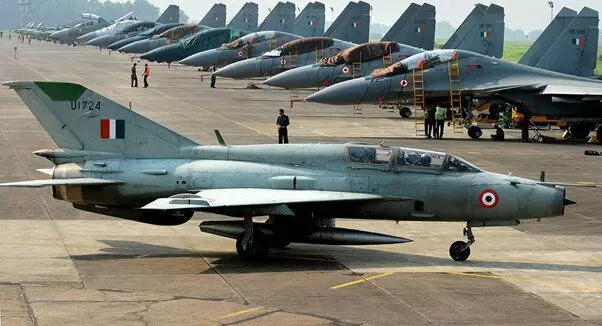Overcoming shortages
The comparative decline in the fighter squadron strength of the Indian Air Force, vis-à-vis China's rapid expansion in this domain, can be addressed through active international collaborations

The Indian Air Force (IAF) is the fourth-largest air force in the world, with a rich combat experience that extends from the 1930s to the present. Characterised by adaptability, agility and audacity, the IAF’s evolution into a dynamic, potent and capable force has garnered global attention. It has played a decisive role in conflicts/wars and Humanitarian Assistance and Disaster Relief (HADR) operations. The diversity of terrain, environmental conditions and geography over which IAF operates (and lands!) is characteristic of its unique ‘Sea to Summit’ ability. For the last four years, assets of the IAF have been actively deployed to counter the unilateral, unprovoked and illegal attempts at ‘land-grab’ by China in the East Ladakh region of the Himalayas. It is no secret that the rapid airlift of troops by the IAF in 2020, their continued sustenance, and the forward deployment of air assets deterred the Chinese. Almost four years into the stand-off, Indian air power remains the principal deterrent against the Chinese. However, the depleting strength of fighter squadrons in the IAF is a worrisome aspect that requires urgent attention.
India’s principal security challenge arises from an expansionist and revisionist China that has actively worked to undermine legitimate Indian interests and genuine efforts at peace. The People’s Liberation Army Air Force (PLAAF) has embarked upon a rapid expansion, including the creation of infrastructure to undertake intense air operations in Tibet against India. Although the IAF retains the qualitative edge in its human resources, the numerical inequality in fighter aircraft has been growing steadily. Moreover, the rate of induction of new aircraft in the IAF and PLAAF shows great disparity. China has ratcheted up its production of indigenous J-10C, J-16 and J-20 (which China claims is a stealth fighter) to approximately 300 annually. In 2016, China’s total holdings of J-10C, J-16 and J-20 were less than 100. By 2022, these had risen significantly to over 600. In contrast, since 2016, the IAF has been able to add only about 76 fighters of the 4th generation. The PLAAF may have about 250 J-20s by now, which are regularly added and upgraded. According to a recent Pentagon report, the PLAAF has about 1,300 of its approximately 1,900 fighters in the 4th generation and above class of fighter aircraft. An estimated 300 or more of these are likely to be deployed against India. IAF has about 260 aircraft of the 4th generation and no stealth ones. This is indeed a very skewed and precarious situation.
To be fair, the IAF has regularly flagged the precipitous decline in fighter squadrons. Instead of procuring 126 Rafale aircraft required by the IAF, the government purchased only 36. The induction of the Tejas has been slow. An improved version, the Tejas Mk 1A, undertook its first flight in March. 83 of these 4.5-generation fighters are on order and expected to be delivered by 2028. India’s quest for a 5th generation fighter rests in the Advanced Medium Combat Aircraft (AMCA) project, which belatedly received approval from the Cabinet Committee on Security (CCS) only in March. Even by optimistic yardsticks, it will take more than a decade to develop and produce it. The Tejas Mk 2 is expected to enter production not before 2027. The IAF chief has been on record stating that even if all inductions take place without any delay, the IAF would have only 35 or 36 fighter squadrons by 2035-36, as against the authorised 42. The pursuit of procuring 114 Multi-Role Fighter Aircraft (MRFA) seems stalled and lost in the election milieu.
Air power is intrinsically ‘hi-tech’ and expensive. Resource constraints, even in rich countries, have motivated them to collaborate in designing and developing modern and future fighters. The Global Combat Aircraft Programme (GCAP) involves the UK, Italy, and Japan collaborating to develop a 6th-generation stealth fighter that will be delivered by 2035. Incorporating futuristic technologies, the project involves over 1,000 suppliers across the partner nations and pools the best talent, practices and domain technology from these countries. France, Germany, and Spain are collaborating on the Future Combat Air System (FCAS), which is on similar lines. Interestingly, each of these countries has underlined that they seek to enhance their deterrence capability, strategic autonomy and regional stability by developing such capable aircraft. Besides strategic sense, these collaborations also make sound economic sense. India enjoys good relations with the countries involved in GCAP and FCAS. Joining either of these programmes will enable the IAF to leapfrog its capability and fill the shortfall in numbers. Indian industry, too, will benefit from technology absorption, the creation of jobs and joining supply chains. The Indian establishment’s penchant for self-reliance should not imply closing doors to fruitful international collaborations. Creating and sustaining deterrence in the aerospace medium is a continuous process. Ignoring or neglecting it is a disservice to the IAF. Worse, it imperils national security.
The writer is a former IAF officer with extensive operational, instructional and staff experience. Views expressed are personal



